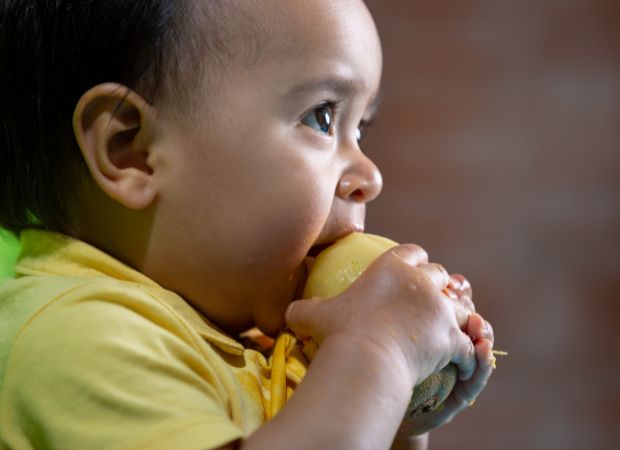When you first start the weaning journey, it can be difficult to ensure that your child is eating enough solid food between milk feeds and naps. While the first year is mainly about introducing solid food to your baby, you gradually want to increase the number of solids they’re consuming as they get older. Some children will take to solid food like ducks to water, while others may still prefer their milk feeds. Either way, it’s important to get the balance right and to encourage your child to frequently try new foods.
How much solid food is “enough” when you start weaning
In Weaning Sense, occupational therapist Meg Faure and paediatric dietitian Kath Megaw suggest starting your baby on solids when they’re between the ages of four and six months. This is when your baby may benefit from an iron boost (as typically their iron stores will start being depleted when they reach this age) and their risk of developing allergies to certain foods may be reduced. But they note that even when introducing solid foods, at this age, milk still takes priority. So, you would start by introducing a tablespoon of puréed fruit or vegetables an hour or two after a milk feed. As your baby becomes more interested in solid foods, you can increase the amount of food offered at that meal. Then gradually build up to adding two, then three, solid meals per day. Always time those meals for an hour or two after a milk feed.
ALSO READ: You can find out more about how to know when the right time is in this article on the COLLAB approach to weaning.
By the time your baby is nine months old, you want to roughly be following this meal plan:
- They should be on three meals a day and be having a mid-morning and mid-afternoon snack.
- You should also be offering solid foods before milk feeds to ensure that they are hungry enough to eat.
- Offer a variety of foods, specifically foods that are rich in iron and protein.
- Introduce a variety of textures, including mash and lumps instead of purées.
- Encourage your child to try feeding him- or herself whole finger foods.
Note that it’s still important to follow and respect your baby’s cues. There will be days your baby will consume more solids than milk, and other days when he or she may appear to not really be eating anything much at all. Try not to stress over how much your baby may or may not be eating at one meal. Instead take stock of how much your baby consumes over a week – it may surprise you to find that they are actually taking in a variety of foods more often than you had realised.
How to ensure your older baby is eating enough
If you followed the plan above, your baby will hopefully be comfortable with a variety of textures, flavours and foods by the time they reach late infancy. The focus now moves to developing independent eating skills, so you’ll want to ensure most of the food your older baby and toddler is eating are finger foods. Here are some other tips to follow:
- Limit the amount of milk your baby consumes. (Some of their dairy needs will also be coming from solid foods in the form of yoghurt and cheese, for example.)
- Stick to a regular routine for breakfast, lunch and supper, plus two to three snacks per day.
- If your baby wakes up much earlier than the rest of the family, you may want to offer him or her a snack before breakfast. Likewise, if your baby goes to sleep much later after supper, you may want to offer a snack before bed.
- Your older baby will likely be crawling and eventually walking and running, which will make it challenging to keep them still long enough for mealtimes! So, ensure that every meal offered provides maximum nutrition with every bite. Think muffins or meatballs loaded with veggies, baked veggie nuggets or smoothies made with plain yoghurt, fruit and seeds.
MUST-TRY RECIPE: Sweet potato cannonballs with hidden veggies
Your child’s paediatrician and nurse will regularly check their growth and plot it on a growth chart. As long as your child’s growth is in line with what’s expected according to their individual chart, you have no reason to stress. Your medical professional will advise you if your child’s weight increases or decreases dramatically.

